If your dog is limping on a back leg, one of many different conditions could be to blame. To help you navigate this situation, integrative veterinarian Dr. Julie Buzby invites rehabilitation veterinarian Angela Youello VMD, PhD, CCRT, CVA to the blog. Dr. Youello discusses 14 reasons a dog is limping on a back leg and when to head to the vet.
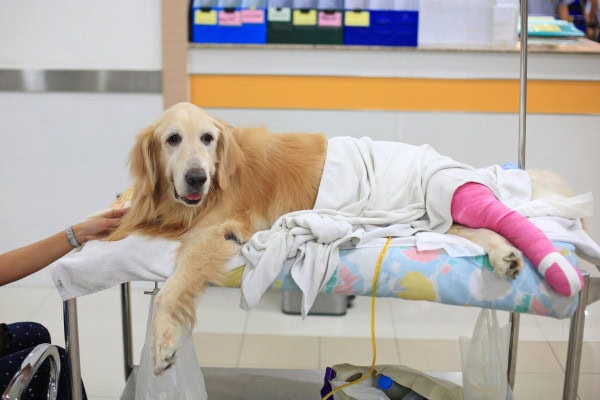
Seeing your beloved dog limp or be unable to put weight on a back leg can understandably spark worry and confusion. Sadly, leg injuries and discomfort are an unfortunate reality for many dogs. Small dogs, large dogs, rambunctious puppies, dogs of all breeds, and even seasoned senior dogs may start limping and face a painful leg injury at some point.
However, all limping dogs have one thing in common—pain. Dogs usually don’t vocalize when they’re injured, so a dog who is limping but not crying out is still hurting.
So why would a dog start limping on a back leg?
To answer this question, let’s start by talking about what a dog’s limping means.
What does limping mean in dogs?
Limping occurs when a dog favors one leg over another to avoid putting weight on the affected leg. Generally, dogs don’t have the insight necessary to decide “My leg isn’t painful, but I can tell something isn’t completely right, so I should avoid putting pressure on it.”
Simply put, if your dog is limping, it is a sign of pain in the leg he or she is using less. And since dogs are stoic and usually do not vocalize when in pain, it’s important to remember that a dog who is limping but not crying is still suffering.
There are many possible reasons your canine companion may have suddenly started limping or for there to have been a more gradual onset of limping with a slow decrease in mobility over time. Some of these causes are mild and will resolve on their own, while others are more serious and need medical care.
When should I take my limping dog to the vet?
One important thing to remember is that if your dog has been limping even mildly for more than 24 hours, it’s time to seek veterinary care. Your veterinarian can thoroughly evaluate your dog’s legs and feet to narrow down the possible causes for the lameness. This helps your vet decide which types of testing are likely to be informative to answer the question “Why is the dog limping?”, and to determine what types of treatment to consider.
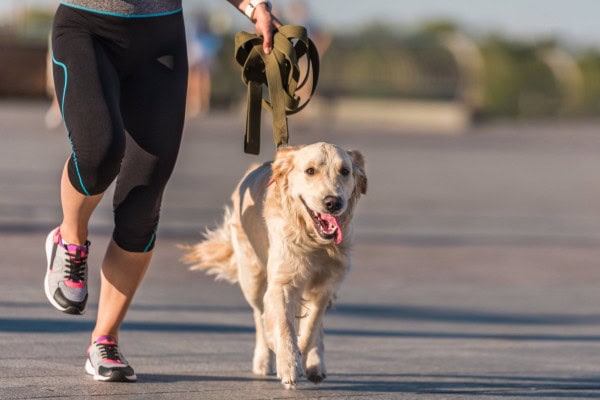
Until you see your veterinarian, confine your dog to one floor of the house. And restrict his or her activity to avoid making a possible injury worse.
If the lameness is mild, is not getting worse over time, and there are no obvious complications like cuts or bleeding, you can schedule an appointment with your regular veterinarian in the next day or two. But if the lameness is severe (i.e. your dog is unwilling to put weight on the leg at all) or there’s another injury involved (such as a cut or laceration), then it’s safest to make an emergency vet visit, rather than waiting it out at home.
Why is my dog suddenly limping on a back leg?
Let’s start by delving deeper into the possible reasons for your dog to be limping on a back leg suddenly. (We will get to gradual-onset limping and limping in puppies in a bit.)
Some common causes of sudden-onset limping on a back leg include:
- An ACL/CCL (anterior or cranial cruciate ligament) tear
- Injury to a paw pad
- Broken or injured nail
- Tick-borne illness
- Soft tissue injury (e.g. muscle strain or connective tissue sprain)
- Dislocated hip or broken bone
1. Torn ACL in dogs
An ACL injury is one of the most common reasons for dogs to suddenly start limping on a back leg. The ACL (or CCL, as it’s more often called in dogs) is one of the primary stabilizers of the knee joint. When it becomes injured or damaged, it causes pain and limping.
Unlike humans, where sudden trauma is the most common cause of ACL injury, gradual degeneration of the ligament is more common in dogs. Often, there is slow accumulation of damage going on behind the scenes for months, or even years, before your dog begins limping on the affected leg.
ACL or CCL injuries can be partial (i.e. only tearing a few fibers of the ligament) or complete (i.e. rupture of the ligament). Being overweight, and having a previous injury to the other CCL are both big risk factors for a torn ACL in dogs.
X-rays can show changes in the knee that make the vet more (or less) suspicious of a CCL injury. But the physical exam is the primary way of diagnosing this condition. The vet can manually test the knee for certain types of instability that tell him or her the CCL isn’t working properly.
Treatment options depend on the severity of the injury, the physical condition of the dog, the dog’s size, and other factors. Some dogs do better with surgical repair of the injured knee (e.g. TPLO surgery for dogs). And for others, the vet may use medication such as non-steroidal anti-inflammatory drugs (NSAIDs), rest, and physical rehabilitation to treat an dog’s ACL tear without surgery.
2. Paw pad injury
A dog paw pad injury can be subtle or obvious. In some cases, you have a healthy dog running around happily who suddenly yelps and starts limping on a back leg. When you look at the affected leg, you see a cut or laceration on a paw pad. That makes the diagnosis pretty clear. In other situations, a dog may step on something very small on a walk. The cut may cause pain but isn’t immediately visible when the foot is examined.
Thankfully, in many of these cases, with protection of the affected foot (e.g. wrapping your dog’s paw), the injury will heal uneventfully. But with more serious injuries, the vet may need to treat a laceration or foreign body surgically.
3. Broken or injured nail
A dog ripping a nail off or a dog splitting a nail is another common cause of lameness in dogs. Sometimes the injury is obvious, such as when the nail falls off completely or is bleeding. In other cases, there may be a small crack or tear in the nail that causes pain but isn’t visible at home.
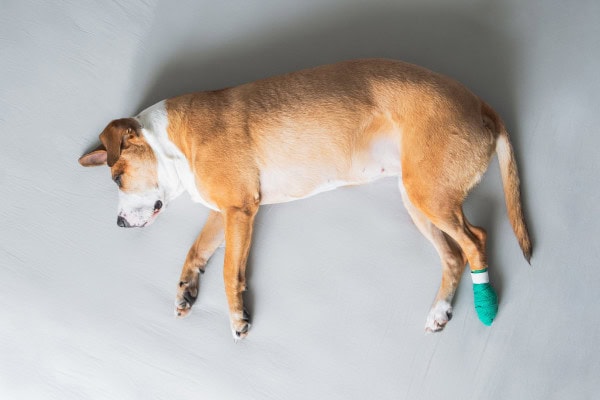
The good news is that with pain management and protection of the foot, this injury will usually heal within a couple of weeks. However, because the nails are in constant contact with the environment, a torn nail is a common site for infection. Make sure to watch for redness, swelling, discharge, or worsening pain while the injury heals.
4. Tick-borne diseases
Tick borne disease in dogs such as Lyme disease in dogs can cause lameness. And they can be tricky to diagnose because the limping can switch from leg to leg! If you see your dog limping on a back leg one day, then on a front leg the next day, that could be a sign that there’s joint inflammation from a tick-borne illness. These diseases can be diagnosed with bloodwork, and most respond well to antibiotics and non-steroidal anti-inflammatory drugs.
5. Soft tissue injury
Soft tissue injuries such as a muscle strain or connective tissue sprain (i.e. injury to a ligament, the fibrous bands that connect bones to each other) are very common in dogs. And they can be tricky to diagnose. Muscle and ligament injuries generally don’t show any changes on X-rays.
So if your veterinarian notices a painful area of your dog’s leg that doesn’t correspond to any X-ray findings, it may be a soft tissue injury.
The pain, swelling, and inflammation caused by the soft tissue injury can make it hard for your dog to put weight on the affected leg. But the good news is that strains and sprains often respond well to rest and pain medication. Plus, in more severe cases, your dog may benefit from physical rehabilitation.
If there’s a sprain causing instability in a joint, your dog might need a brace to stabilize the joint while the ligament heals. Or in some situations, the vet may need to treat sprains surgically if they’re not healing with rest and pain management.
6. Broken bone or dislocated hip
Some causes of lameness are more immediately obvious. If your dog suddenly starts limping or holding a leg up after a known injury or trauma, a broken bone or dislocated joint (e.g. hip) could be the culprit.
There are many different ways your dog could get hurt. Falls can occur when dogs climb stairs, jump off furniture, or even just lose their balance. Falls are not always serious. But sometimes they can result in fractures or dislocations, especially if the fall was from a tall piece of furniture or your pup landed at an awkward angle.
Playtime can cause fractures or dislocations when dogs are running around and accidentally collide with each other, or with objects like trees. Sometimes we’ll see broken toes in dogs when a dog is accidentally stepped on. This can easily happen in the dark when your dog is sleeping and doesn’t move out of your way.
If your dog has an incident like one of these, and immediately stops putting weight on one of the legs, a broken bone, or a dislocated hip are high on the differential list. A thorough exam by your veterinarian and X-rays of the affected leg will usually provide a diagnosis.
Treatment will depend on the age of your dog, which bone or joint is affected, and the type of fracture or dislocation that occurred. In some cases, splinting and bandaging to support the affected area, combined with strict rest for several weeks, is enough to allow the injured area to heal. In other cases, surgical repair is needed to provide relief.
Why did my dog gradually start limping on a back leg?
On the other hand, sometimes a dog will gradually start limping on a back leg or only limp on and off. Potential causes of a dog slowly or intermittently starting to limp include:
- An ACL/CCL tear
- Arthritis
- Iliopsoas injury
- Luxating patella
- Hip dysplasia
- Osteosarcoma
1. Cruciate ligament (CCL or ACL) injury
We talked about CCL injuries being a common cause of sudden limping in dogs. But they can also cause gradual-onset lameness. Because the injury is more often caused by degenerative changes in the ligament, dogs with a CCL injury can start out with a very mild limp as a few fibers of the ligament are affected. And then the limp may slowly become more obvious as the CCL accumulates more damage.
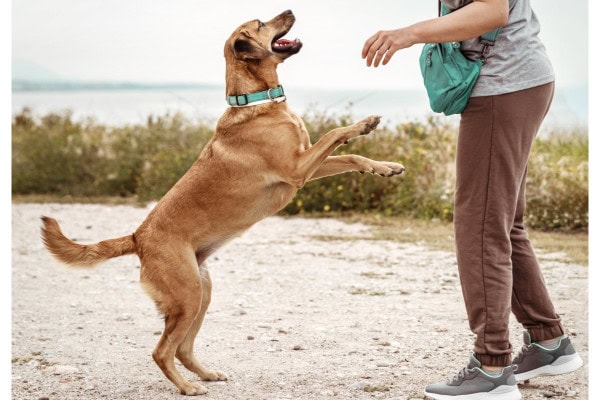
Diagnosis and treatment for CCL injuries are similar for both sudden and gradual-onset limping. But it’s worth noting that a CCL injury will lead to arthritis in the affected knee. Whether the injury is repaired surgically or managed medically, the inflammation and instability in the knee will cause arthritis to develop over time. In fact, some dogs with CCL injuries are not diagnosed until the arthritis becomes the cause of their limping. This tends to be the case if they accumulated tiny amounts of CCL damage over long periods of time.
2. Arthritis
Osteoarthritis in dogs is the most common cause of gradual-onset limping in dogs. It is caused by joint inflammation that leads to wear and tear of the cartilage.
Normal joints contain lubricating fluid and cartilage that cushion the bones in the joint from force during movement. When the joint becomes inflamed, the fluid becomes thinner and less lubricating, and the cartilage starts to deteriorate. This reduces the shock-absorbing ability of the joint. And eventually it leads to bony changes that cause more inflammation, pain, and stiffness.
The classic description of an arthritic dog is one that is stiff and seems sore when first getting up in the morning or after a long nap. As the dog moves around and warms up, he or she gradually becomes more mobile and comfortable. Additionally, arthritic joints are often more painful in cold or damp weather, so winter can be hard on arthritic dogs. If you notice symptoms like this in your dog, arthritis is high on the list of possible causes.
Managing arthritis in dogs
There are many ways to relieve arthritis pain in dogs. Joint supplements for dogs (e.g. Dr. Buzby’s Encore Mobility™ hip and joint supplement or other glucosamine and chondroitin products), omega-3 fatty acids for dogs, and injectable products like Adequan for dogs can help keep cartilage healthy longer.
NSAIDs such as carprofen for dogs are very helpful in relieving pain and inflammation. And gabapentin for dogs can be used in conjunction with NSAIDs (or instead of them for dogs that have an underlying health condition that prevents them from taking NSAIDs).
Physical rehabilitation can help maintain muscle strength, joint mobility, and coordination as well as relieving pain. And acupuncture for dogs can provide pain relief as well. Plus, mobility aids like Dr. Buzby’s ToeGrips® dog nail grips can help your dog walk more confidently, even on slippery surfaces.
Most dogs with arthritis will need long-term treatment. Arthritis is a condition that doesn’t improve over time. Thus, it’s important to continue managing weight, cartilage health, and pain throughout the rest of your dog’s life.
3. Iliopsoas injury
Iliopsoas injury is a specific case of muscle strain (similar to a strained groin muscle in humans). It often causes gradual slowing down, a shorter stride when running, reluctance to jump up onto elevated surfaces, and eventually an actual limp. Occasionally, the iliopsoas will become acutely injured during a slip and fall, or during strenuous activity. But more often it develops chronic wear and tear that eventually leads to pain.
Iliopsoas injury can be difficult to diagnose. Usually the vet will base the diagnosis on a combination of the history, physical exam findings, and lack of abnormalities on X-rays. The primary treatment for iliopsoas injury is physical rehabilitation combined with activity restriction and pain management. An iliopsoas strain can take longer to heal than other muscle strains because it’s a muscle that’s constantly being used.
Sometimes, the iliopsoas strain is secondary to a different problem (such as a knee injury or hip dysplasia). In that case, it is important to also address the primary problem in order for the iliopsoas to heal.
4. Patellar luxation
Luxating patella in dogs is a common cause of intermittent limping in small breed dogs (and occasionally in large breed dogs). In tiny dogs, it’s common for the groove where the patella (i.e. kneecap) sits to be shallower than normal. This allows the patella to luxate (i.e. pop out of place). Usually this causes temporary lameness that may only last a few moments. And then the kneecap repositions itself normally, and the limp goes away. Some dogs with luxating patellas never limp at all!

Treatment depends on the degree of luxation and how often it happens. It can vary from joint supplements and physical rehabilitation to helping your dog lose weight to prevent additional strain on the knee. And in severe cases, treatment may involve surgical repair.
5. Hip dysplasia
Hip dysplasia in dogs is an inherited condition that occurs when the hip joint does not develop properly. The hip is a ball (i.e. head of the femur) and socket (i.e. acetabulum of the pelvis) joint. And when it is dysplastic, the ball and socket don’t fit together normally.
This causes looseness or laxity in the joint. Over time, this will grind down the cartilage and cause inflammation that leads to arthritis. Early detection gives us the most options for treatment, since there are surgical procedures that can improve the conformation of the hip joint and slow the development of arthritis.
Many dogs, however, are not diagnosed until they begin actively limping later in life. In these cases, treatment involves maintaining a healthy weight, using joint supplements to promote cartilage health, and giving pain medication as needed. Plus, providing physical rehabilitation to maintain muscle strength and address any secondary issues can help relieve discomfort and lameness. In severe cases, surgical options (e.g. dog hip replacement) are available even later in life to relieve pain and allow normal mobility.
6. Osteosarcoma
Osteosarcoma in dogs (i.e. bone cancer) is a less common cause of lameness. Typically osteosarcoma most commonly affects the lower part of the femur (i.e. thigh bone) and upper part of the tibia (i.e. shin bone). Bone cancer is usually very painful, and the pain is not alleviated by rest or activity restriction. Dogs with osteosarcoma are often reluctant to bear any weight at all on the affected leg.
Unfortunately, osteosarcoma is aggressive and treatment usually involves a dog leg amputation followed by chemotherapy. There are a lot of factors to consider before pursuing such an extensive treatment plan. But your veterinarian can be a great resource to guide your decision making.
Why is my puppy limping on a back leg?
Puppies can suffer from some of the problems discussed previously. But there are also a few conditions that cause lameness primarily in puppies that you should be aware of. They include:
- Osteochondritis dissecans (OCD)
- Panosteitis
- Hypertrophic osteodystrophy
1. Osteochondritis dissecans (OCD)
OCD or osteochondritis dissecans in dogs occurs when an abnormal flap of cartilage forms during development. In some cases, it will detach from the surface of the joint and cause instability in the joint. This results in pain and limping. And later down the road it can cause arthritis too.
OCD most commonly occurs in certain large and giant breed dogs during periods of rapid growth. And treatment usually involves surgery to remove the offending piece of cartilage and limit further damage to the joint.
2. Panosteitis
Panosteitis in puppies is similar to “growing pains” in children. It occurs when the long bones of the dog’s legs become painful during growth. Panosteitis often causes lameness that comes and goes, can be very painful during flare ups, and is sometimes accompanied by fever. Most dogs outgrow the condition by 12 to 18 months of age. And they can be managed with NSAIDs and other pain medications as needed in the meantime.
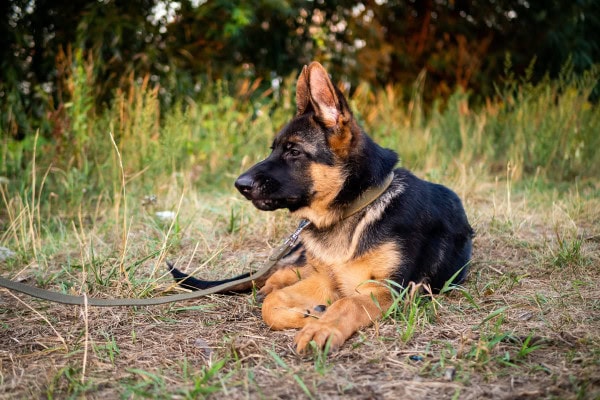
3. Hypertrophic osteodystrophy (HOD)
Hypertrophic osteodystrophy (HOD) is another painful condition that affects rapidly growing, large breed dogs. It occurs when changes in blood flow affect development of the bones near growth plates. Unlike panosteitis, which will resolve without complication in most puppies, HOD can cause damage to the growth plates.
Most puppies with HOD will have a limp that can affect one or more legs, and the affected leg(s) may be swollen and warm. In some cases, the dog may develop other signs like loss of appetite, lethargy, and fever. Most puppies will respond well to medical management, which can involve NSAIDs or steroids (e.g. prednisone for dogs) to suppress inflammation.
If your dog is limping, head to the vet
There are so many possible reasons for dogs to limp on a back leg. So it can sometimes take some detective work to figure out exactly what is going on.
The most important thing to remember at home is that limping is almost always a sign of pain in dogs, even if they’re behaving normally otherwise! Dogs rarely vocalize in pain and many painful dogs will still eat normally and want to play. Therefore, the only sign of discomfort they give may be lameness.
If your dog suddenly develops a severe limp, it’s safest to seek immediate veterinary care, even if that means a visit to the ER. Otherwise, if your pup has a mild limp, or you notice that an ongoing lameness has become worse over time, then a visit to your veterinarian is the best way to figure out what’s going on. Plus, the vet visit can help ensure you have the resources you need to help your best friend be comfortable and pain-free.
Why was your dog limping on a back leg?
Please comment below


My two year old golden retriever started to limp off and on a few days ago, she is fine all throughout the day she’s still very active running, jumping, playing. She is not crying or anything just when she first wakes upmost randomly she will limp for. Very short period of time then be perfectly fine.
Hi Stormy,
I understand your concern for your Golden with this limping she is exhibiting. While I can’t make specific conclusions without examining her myself, I can say that this does need to be evaluated by your vet. I know you mentioned your pup is active and has no issues during the day, but these could be early signs of a developing orthopedic issue. Hoping you can partner with your vet to do the appropriate testing to help get some answers. Wishing you both all the best of luck!
My puppy is 4 months old. She was totally fine, we took her outside before going to bed for her last potty break of the day before going to bed, and I noticed she was limping on the left back leg. She won’t put any weight on her leg. No accident, she didn’t hit anything.
Hi Lulu,
I am sorry your puppy is limping. You are right to be concerned especially since there was no accident or obvious injury. Unfortunately, I can’t offer specific conclusions or recommendations without being able to examine her myself. Your best bet is to call your vet and see if they can get her in for an appointment. Maybe she got stung or bit by a bug? Did she get a splinter or something stuck between her paw pads? Hoping you can get a definitive answer and praying all is well with your sweet little pup.
Irish Doodle is nine years old. He had a cyst that popped 9 months ago. It has been drained and antibiotics. It heals and opens up. Today it’s bleeding a little. I can’t afford a $1,600 surgery right now. This morning he was walking with a bad limp on his back leg. Could you give me some encouragement or advice. Thanks for your time Miss Lee
Hi Miss Lee,
I am sorry your senior guy has developed this new limp with his rear leg. I would be surprised if the cyst could cause something like this, but without examining your pup myself I can’t make specific conclusions. Your best bet is to schedule an appointment with your vet and allow them to do a thorough evaluation. Hoping for clear answers and an easy solution. Best wishes to you both!
My long hard Chihuahua jumped over a bar and landed on a metal pole left in the ground on Saturday. He started limping but shas since stopped. He scents the ground with his foot and yelps a bit. Recently he has stopped scenting and jumping up on the furniture and he has stopped limping but walking okay now. He is not licking, biting or seems to be in pain. He is eating and drinking well still.
Hi J’annine,
I am glad your boy seems to be improving since he injured his leg a few weeks ago. Without examining him myself it is hard to offer advice and specific recommendations. If you have any lingering concerns, it would be best to have your vet do a thorough evaluation. Praying for a full recovery and wishing you both all the best!
My 2 yo English Shepherd may have slipped on our floor and strained a leg 2 days prior to developing symptoms (quick yelp and lifted back paw, then laid down). The next 2 days he was walking and jumping like usual. He woke up on the 3rd day reluctant to bear weight on his right hind leg, but no swelling is visible, except maybe minor increase in size on his right inner thigh (groin). He prefers to lay on his back with legs spread wide open. He will walk when highly encouraged, but collapses into a seated/laying position whenever possible. He has no obvious signs of pain (yelping, panting, loss of appetite) so it’s very mysterious. I’m thinking acute iliopsoas injury but do hard to know!
Hi Steph,
I am so curious to know what you do for a living! While reading your comment, in my mind I am thinking about a strain to the iliopsoas tendon or muscle but was not expecting to see it mentioned by name. It would still be a good idea to have your vet do a thorough evaluation to rule out other possible causes. Then, if this does turn out to be a simple muscle strain, they can prescribe some anti-inflammatories to help with the healing process. I think you are on the right track and feel certain your Shepherd can make a speedy recovery. Best wishes to you both and keep up the good work!
Thank you for reviewing and responding! It is so helpful to have another perspective on this besides my own : ) I know about human iliopsoas issues, so when I saw dogs have this too I wondered if it could be the culprit. With no improvement today, we’ll be making a trip to the vet for anti-inflammatories.
He was playing with his “cousin” and she fell on his back leg she’s 80 lbs he’s 21 and for over a week he refuses to put his paw completely on the floor or use it except maybe to scratch his ear only because he has to. Gyzzmo doesn’t cry unless you pick him up wrong than it’s a quick yelp, I believe it’s his paw or ankle if it was his upper leg I think he could or would put the paw down but when walking it stays up all the time , going to the vet tomorrow just hope I didn’t mess up by not going sooner
Hi Debra,
I am sorry your little pup has sustained this worrisome injury. With what you describe I am very concerned about a fracture. I highly recommend you take your boy to the vet as soon as possible to have him evaluated. Hoping you were able to get a definitive diagnosis and praying for a positive outcome.